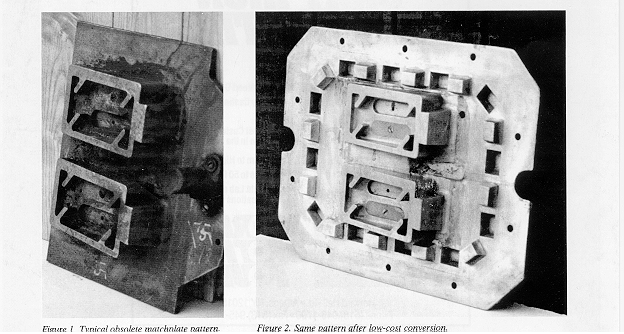
 |
Mold-Pattern Conversion Yields Low-Cost, Modern Foundry Automation
by Roger A. Lew
President
Wormuth Brothers Foundry
Athens, NYFor many years, foundrymen have struggled to adapt matchplate patterns, originally designed for "hand" or "squeezer" molding, to automatic flaskless molding systems. If the adaptation was successful, the foundry's customer reaped substantial gains in productivity because typical daily mold counts for an individual molder using a "squeezer" machine would amount to 100 to 175, while a fully automatic machine will routinely turn out 750 to 1,000 molds daily.
However, more often than not, conversions of obsolete matchplates have created more headaches and problems than solutions. The biggest concern is usually cost, because in most cases where a pattern has been around for a long time, the end product involved is either in a declining market or at least in a mature industry with essentially low or no growth and low volume. Making a new pattern plate for use in an automatic molding machine costs anywhere from $2,000 to $3,000, depending on the complexity of the casting. In most cases, the cost for new patterns is prohibitive even though substantial per casting savings will result. Lower volumes just do not justify the tooling expenditure.
Because of the limitation imposed by the need to give our customers a reasonable return on their tooling dollars (and the demand for quality castings), we decided to develop a low cost conversion package for matchplate patterns which would yield tooling equal to the quality of new patterns.
We re-thought what we had been doing up to that point. Instead of adding and subtracting to the existing plate by cutting and welding, we created a new plate for insertion of the old pattern impressions. By starting out with a new plate we could control the exact size and shape as it related to our system. Next, we found that by splitting up the functions and contracting for them ourselves, we could control the cost. We developed a uniform format for the various shapes and sizes of patterns we were converting so that our plate casters and welders became more efficient.
Turn-around time is less than half that of making a new pattern, and in almost all cases, conversion cost to the customer runs less than 30 percent of the new pattern price. Figure 1 shows a typical obsolete type pattern. Figure 2 is the same pattern after it was retrofitted using the insertion method.

An additional benefit beyond the obvious casting price savings and lower pattern cost is the fact that with their new low cost, state-of-the-art matchplates, our customers have easy access to many more vendors, our competitors actually, because we use the most popular matchplate molding system in the United States.
By converting old, virtually obsolete tooling, the castings buyer can bring his per casting costs down substantially, greatly prolonging pattern life and in most cases improving quality. Our customers have experienced paybacks as short as two months, with the average about nine months. This only takes into account casting price reduction and does not include quality improvements such as superior dimensional stability and better on-time performance as a result of increased productivity.
About The Company
At Wormuth Brothers Foundry, a gray iron sand casting facility, a modern cupola, fitted with direct tuyere oxygen enrichment, along with strict procurement practices, assures customers of consistent, machinable iron in Grades 25 through 40.
Iron at the spout is tested many times daily for those chemical and physical characteristics that insure ease of machining. Cores are made on Redford Carver fully automatic shell core machines. Oil sand and no bake cores are also available. Hunter molding machines with automatic core setters are the primary means used for medium and high volume production. Flask size is 14" x l9". Low-volume, larger castings to 400 pounds are also handled with cope and drag equipment.
|
|
| Home | About Us | Back To Technical Library | Contact Us |
|
Copyright © 1996-2010 JobShop.com. All Rights Reserved. General or Technical Questions? E-mail support@JobShop.com |